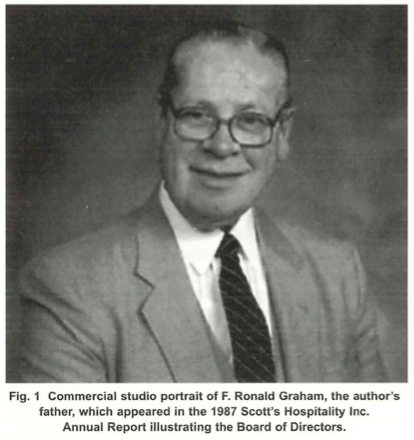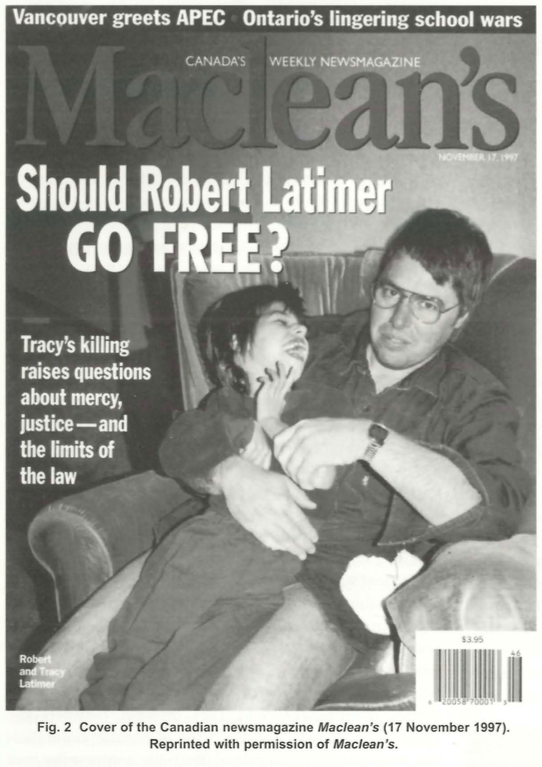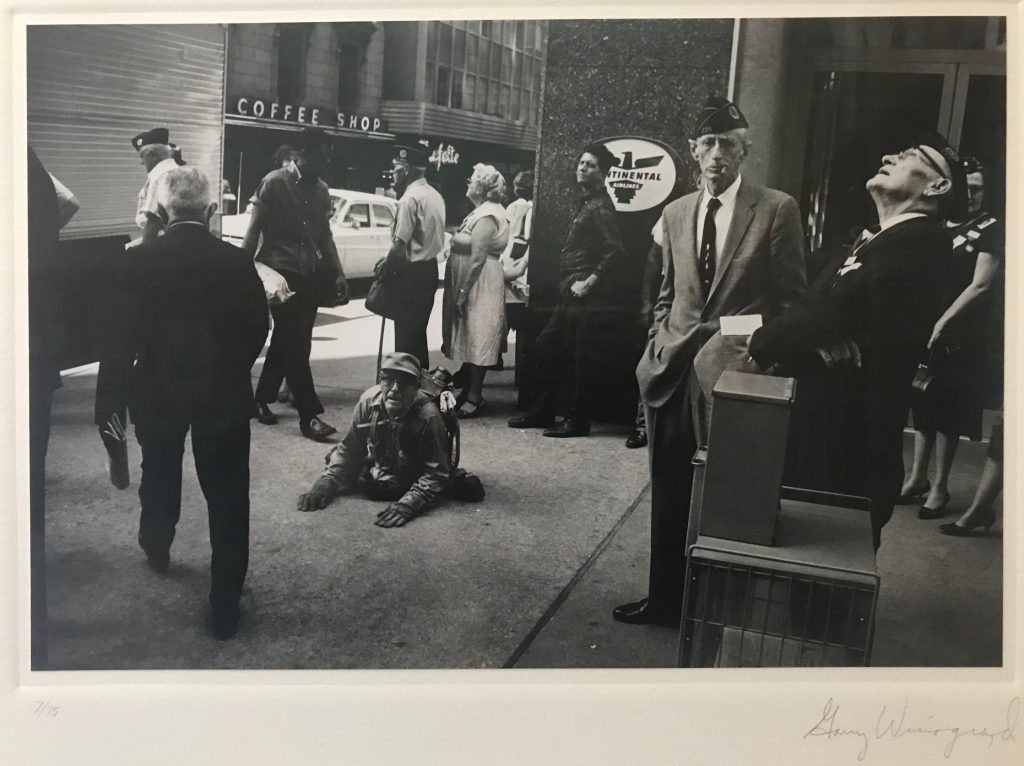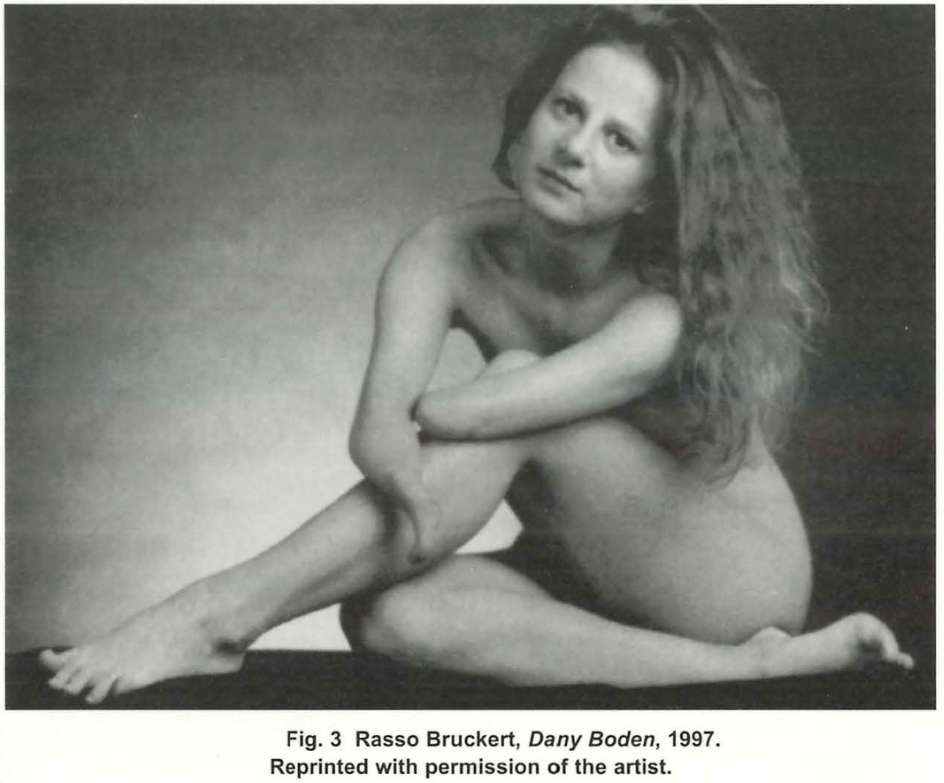Disability Without Tears: The Neutralization of the Grotesque (1998)

Graham, Robert. (1998). Disability Without Tears: The Neutralization of the Grotesque. Exposure, 31(3/4), pp. 25-30.Before he ultimately lost his battle with cancer in 1994, my father had lived for fourteen years with the consequences of a laryngectomy (Figure 1). This operation successfully prolonged his life, but left him disfigured with a hole at the base of his throat, a strange respiratory arrangement (he breathed and coughed through the stoma) and the loss of his voice. To compensate he was required to speak with a microphone-like noise generator that he placed against his throat and which could produce a usually comprehensible yet somewhat robotic voice. Often when I was with him in public I saw people responding to his speech in bizarre and inappropriate ways. Sometimes they would shout at him or speak with elaborate articulation as if he were deaf, or maybe somewhat dim. At other times they would just turn to me and discuss him in the third person as if he were completely absent. What was a very specific and limited handicap became, for many, perceived as the diminishment of his entire person. It would appear that among their other afflictions, the disabled are forced to suffer as living synecdoche.
As a member of his circle of affection and familiarity, I did not consider my father grotesque, yet many might have. Personifying A. D. Coleman’s definition of the grotesque photograph, my father could arouse “discomfiture, anxiety, anger.”‘ In previous times, this discomfiture and awe expressed itself in superstition. While it was considered lucky to see or help a blind man, encountering the lame was unlucky. Gamblers and actors knew to touch the hump of a hunchback, who could then properly expect payment in return. In the Middle Ages, ugly persons were considered the Devil’s spawn. 2 They in society who have been cast in the role of grotesques can be defined as those whose bodies deviate enough from the norm as to cause the usual matter-of-fact mutual body imaging to be suspended. We are aware of the other body and self-conscious in our observing. (One could argue that the very beautiful have the same effect of dislodging the conditions of ordinary encounter.) For the abled, the disabled throw up a whole series of negotiating requirements and conditions that simply don’t exist in .abled-to-abled engagements. Of course, with time and exposure, such meetings becomes regularized, routine, and comfortable, though perhaps never entirely losing their special character or demands. Furthermore, in accepting the goal of normalcy, the disabled often develop extremely skillful compensatory strategies which, when successful and hidden, can provide a “cloak of competence. “3 This division between the space of the grotto and the sites of regular habitation has its analogue in an actual disability controversy over the competing strategies of mainstreaming the disabled or segregating them in special programs and spaces.
This discomfort is somewhat strange, for the abled are separated from the condition of disability by only the slightest of boundary membranes. The alterity of the disabled is contingent and flimsy. However independent, capable and autonomous any of us are, most of us are fated for the grotto. Few will go directly from upright to dead. Decline and increasing dependency is the natural progression. While Philip Larkin queries the senseless and mysterious acceptance of aged decrepitude in his poem “The Old Fools,” it is a state, he also concludes, of which, “Well/ We shall find out.” Anthony Giddens identifies this unease as characteristic of modernity and part of a general “sequestration of experience,” which he defines as, “the separation of day-to-day life from contact with experiences which raise potentially disturbing existential questions – particularly experiences to do with sickness, madness, criminality, sexuality and death.” 5
The conflict over disability is not limited to the micro-environment of individual encounters. Disability has become a quality-of-life issue and has intertwined with larger social issues of life mastery such as birth control, abortion, euthanasia and mercy killing. The increased abilities and sophistication of life technologies has brought a predictability and control over life-and-death choices. Certainly, eugenic theories as instruments of governmental social engineering are entirely in disrepute, and recent revelations of past state sterilization programs in Sweden, Canada, and France have been treated as scandals. Yet advances in genetic knowledge and the increased facility of genetic testing have re-distributed the application of eugenic principles (“The Fit Only Shall Be Born””) to everywhere. Genetic counselling and reproductive technologies give anyone the ability to determine the fittingness of their offspring. Instead of centralized fiat, we have the broadly dispersed market of individual choice.

This is not an abstract issue. During this past year. Canada was the scene of a trial appealing the murder conviction of Robert Latimer, a Saskatchewan farmer. In 1993, Latimer had asphyxiated his 12-yearold daughter Tracy who had been born with cerebral palsy which so convulsed her body that she had to have several operations to repair the damage and stem the pain. While she could hear (and she apparently liked music). she could neither speak nor move with any control. Photographs released by the family (Figure 2) showed her as a loving and laughing child. She was being prepared for hip surgery to correct a painful deformation when Latimer placed her in the family pickup and fed a rubber tube from the exhaust into the closed compartment.
Latimer had confessed to the act, and the jury convicted him of second-degree murder, though they also recommended a light penalty. But the conviction carried with it a mandatory life sentence with no parole for a minimum of ten years. The judge, in his sentencing, ruled that the Canadian Charter of Rights protected citizens against “cruel and unusual punishment,” so he decided to overrule the mandatory minimum and sent Latimer to jail for less than two years. In wanting to relieve Tracy Latimer of her pain, Robert Latimer had committed, the Judge wrote, “for caring and altruistic reasons … compassionate homicide.”
Public response was divided. Many were sympathetic to Robert Latimer and considered the judgement and leniency acceptable. The disabled community, on the other hand, was irate. The sentencing, they felt, said that their lives had discounted value: they could be murdered at the caprice of their caregivers. Margaret Somerville, McGill University professor of law and medical ethics noted, “that Tracy was discussed in Judge Noble’s ruling only in the context of her incompleteness. ‘She didn’t exist for him. She was a cypher.’ 7
Artwork which is related to the grotesque, in literature as well as photography, is usually work that is peopled by those with disability markers: the blind, the lame, retarded, amputees, etc. In fact, they usually become overmarkers in which a single aspect comes to encompass the whole. In the debate over pornography, some sex-affirming feminists have sought an holistic pornography which represented the eroticization of the whole body, the entire person. So it is that critics among or on behalf of the disabled decry an imagery which relies upon the misleading and overdetermining marker of the disability to portray the person. The disability movement insists that the customary definition of the disabled misplaces the stresses: they are abled as well as disabled and their problems are not innate, but the difficulties experienced by living in a hostile environment.
Grotesque photography is theatrical and imaginative while disability imagery shows actual people. To put this another way, the naturalist medium of photography applied aesthetically provides symbolic relations for actual people. For the meaning we gain from a work of art which figures a disabled person in part comes from how we think about disability; and how we feel and think about disability in part comes from the meanings we garner from art. The course of the public image of a photograph is circular and recursive.
The disability movement is not without its academic and intellectual cadre or its literature. Christopher Nolan’s Under the Eye of the Cloclc is the autobiographical novel of a boy whose writing polevaults him over the barriers of his extremely handicapping spastic condition. In Autobiography of a Face, Lucy Grealy recounts her experience as a young girl growing up with the effects of facial cancer and disfiguring surgery. And Ann Hill Beufs Beauty is the Beast: Appearance-Impaired Children in America assesses the hurt done by a beauty norm to those who fail its measure. 8
From within the disability movement there has developed a critique of art photography’s appropriation of misery and mis-representation of identity, leadingly articulated by the British writer and film-maker David Hevey, “a disabled person and an issue-based photographer. “9 Hevey is particularly suspicious of photographic carpet-baggers from the land of the well who prey upon and exploit residents of ill-country. The disabled say: we don’t want to function as models for your metaphors of good and evil, health and putrefaction, “the nightmare transference of non-disabled people.” 10 As such, he reiies heavily on the criteria of membership (image-making from the inside) and he recounts with some satisfaction haw Diane Arbus was once refused a request to photograph at a little people’s convention: “We have,” the organizers informed her, “our own little person to photograph us.” 11 Hevey’s goal is to “begin to create a disabled agenda for the production of disability photographic imagery to suit the attendant growth of the disability access movement.” 12 The bias of his goal is to show the disabled less hurting, more succeeding and generally enjoying free access to all social domains and activities. His aim is for the integration of the disabled into the mainstream. One of the elements forming Hevey’s position was his experience in assisting a commercial photographer who worked for a business journal:
The subjects were ‘captains of industry’ who used their bodies to carry their brains around. The fact that many of those photographed were, in reality, disintegrating, vastly overweight and tucking their shirts into their underpants was all hidden by the designs of the photographer’s images which stripped down the subject into two or three key signifiers of power …. People who were, despite their positions, falling apart became, first in the Polaroid and then in the large-format transparency, bastions of symmetry, order and power. This was an important lesson … because it created a vision of the subject in accord with their professional purpose … rather than their physical self. In the image, they were auditioning for the part of themselves as myth. What was interesting for me was the process by which this ‘positive· image came into existence. It seemed that I had witnessed the bones of a process which might be reworkable in a different context and produce more radical results. 13
The term for this kind of photography is “subjunctive:” the photography of advocacy and advertising which presents “that-which-does-not-take-place-but-is-thinkable … something-that-might-have-been.” 14 Or, I would add, what-might-yet-be. It is the photography of promotion (Figure 1) and progress, which is valued not for its accuracy but for the worthiness of its goals. This willing-of-images-to-be has a commercial counterpart in sales motivation techniques and in medicine, especially in visualization therapy, whereby the patient is taught to practice a mental focusing on the disease and then to imagine and project its riddance. It is, of course, anti-grotesque.
In a brief historical survey of disability imagery, Hevey is particularly harsh with the work of Diane Arbus and Garry Winogrand. Certainly they did not operate out of an emancipatory intent. As Winogrand’s friend Joel Meyerowitz described it, it was an aesthetic of the tough:
“Tough” was a term we used to use a lot. Stark, spare, hard, demanding, tough: these were values we applied to the act of making photographs. “Tough” meant the image was uncompromising . It was a type of picture that made you uncomfortable sometimes. You didn’t quite understand it. It made you grind your teeth. At the same time, though, you knew it was beautiful. because “tough” also meant that – it meant beautiful too. 15

In the famous 1964 photograph, American Legion Convention, Dallas, Texas, Winogrand showed an elderly legless man on an active street corner surrounded by passersby, all of whom are busy looking anywhere (even up at the sky) rather than allowing themselves to look at him. In a discussion with Colin Westerbeck, Meyerowitz described the photo in theatrical terms.
CW: Why was Winogrand drawn to dwarfs, cripples. to marginalized subjectsbof various kinds? Did he see in such street people some kind of reflection, however metaphorical, of himself?
JM: These pictures are both unflinchingly funny and tragic at the same time. They’re tragicomedies, which is what Garry’s own life often was. 16
But for Max Kozloff the picture is about looking:
We spectators see what those in the picture do not wish to see, and their reluctance becomes the subject of our look .. .. More than one thing can be said about the refusal to look upon a grotesquely maimed fellow human being. Decency, timidity, or callousness . It is only when license is given through some sort of signal, that a group will permit itself to stare in public. The photograph has become our mass means to stare in private. 17
The legless man occupies the empty centre, he is a negative cynosure of visual avoidance. Is that what Hevey meant when he wrote that, “Winogrand did not produce any images … whose central character was the disabled person or disablement. “?18
Looking and showing rights remain contentious. I know one photographer who over the years has taken many pictures of the crippled and deformed but would find it very difficult now to exhibit them. Yet at least one group within the disability movement, The Disabled in Action Singers, recognizes the comportment issue in a song they perform called Let the Children Stare. The disabled are de-shaming and redisplaying, not as one of P. T. Barnum’s freaks or curiosities, where “the work of each one of them was to be looked at,” 19 nor to serve as a memento Christi like Dickens’s Tiny Tim who, “hoped that people saw him in the church, because he was a cripple, and it might be pleasant to them to remember upon Christmas Day who made lame beggars walk and blind men see.” 20 By integrating with their affliction the disabled treat the illness or handicap as constituent of their identity, not alien to it. Conventional health is not the highest value and, if they should conflict, the preservation of identity usually trumps the preservation of health (or even of life itself). The grotesques are fighting back, embracing their conditions and their disfigurements and resisting the perceptions, “that disability is a tragedy, that we who have disabilities are deficient or damaged, and that suffering and ·loss are the central components of our lives. “21
Part of the struggle is axiological, and includes quality-of-life questions, productivity and usefulness, and especially issues of appearance values. While the spastic narrator in Christopher Nolan’s novel refers to “the beauty of normality,” 22 others maintain contrary standards: “‘I came to see disabled people as beautiful,’ said Danny Robert, who has multiple sclerosis. ‘Particularly people on respirators, people in wheelchairs, people who spasm a lot, people who drool. “’23 While Ann Hill Beuf, in Beauty is the Beast, admits the usefulness of cosmetics as a “concealment strategy,” she also advocates reducing the status of personal beauty itself. 24

About the photograph from Mainstream: Magazine of the Able-Disabled (Figure 3), the model (Dany Boden) writes, “For goodness sake! / Why are you always staring at my short arms? / Why don’t you look at me as I am? / From top to bottom. All that is me!” And the photographer, Rasso Bruckert, adds, “Seldom does any person fulfill the ideal of beauty in our time; even less so the person with a physical disability. And so it is a matter of redefining the concept of beauty, to consciously and individually create it for yourself. “25 Personal and individual love (which is everyone’s proper claim) has become collapsed into the mass competition of evolutionary sex and beauty games, which all seem to want to play. Just as Hevey wants to democratize the subjunctive effect of the bourgeois portrait, so others seek to universalize a solipsistic vanity.
Contemporary thought on the matter refuses interiority. One cannot sidestep the issues of visible stigma by deciding simply to overlook them on behalf of a more profound inside identity. Abraham Menashe’s 1980 photographic project Inner Grace has as its subject “the multihandicapped institutionalized individual. This includes the retarded, the blind, and the cerebral-palsied.” Menashe displays one kind of religious approach that “images reveal beauty in the distorted body and bring us closer to the conquering spirit in man.” 26 I have no doubt that there is a constituency for this kind of work, but it is a particularly sentimental kind of religiosity and very different from the tough love faith of that fabulist of the grotesque, Flannery O’Connor. In her Introduction to A Memoir of Mary Ann, (the story of a pious girl disfigured with cancer who had lived under the care of nuns until her death at twelve) O’Connor expressed her doubts about the “popular pity” sick children engender:
we mark our gain in sensibility and our loss in vision. If other ages felt less, they saw more, even though they saw with the blind, prophetical, unsentimental eye of acceptance, which is to say, of faith. In the absence of this faith now we govern by tenderness When tenderness is detached from the source of tenderness, its logical outcome is terror. It ends in forced-labor camps and in the fumes of the gas chamber. 27
The correct, but interim strategy of giving voice to the silenced has to be followed by dialogue, not out of fairness, but in practical and political recognition that if you take away voice, you increase the amount of exit. 28 As is often stated, disability is not an innate condition but a difficulty in dealing in the world: it is a relationship. The well and the ill are bound together. Proper integration of the disabled will not come from competing images, but from a dialogical imagery, an imagery which admits of alterity. In our grotto stage we should expect to be treated then as well as we treat others now. For Flannery O’Connor:
This action by which charity grows invisibly among us, entwining the living and the dead, is called by the Church the Communion of Saints. It is a communion created upon human imperfection, created from what we make of our grotesque state. 29
Notes:
1 A.D. Coleman, The Grotesque in Photography (New York: Summit, 1977), 6. We cannot deny the occasions of anger: in my father’s instance, conversation with him required a patience from others that was often lacking.
2 Iona Opie and Moira Tatem, A Dictionary of Superstitions (Oxford: Oxford University Press, 1989).
3 Psychologist Robert Edgerton quoted in Sallie Tisdale, “Neither Morons nor Imbeciles nor Idiots: In the company of the mentally retarded,” Harper’s, June 1990, 51.
4 Philip Larkin, Collected Poems (London: Marvell Press & Faber and Faber, 1988), 197.
5 Anthony Giddens, Modernity and Seif-Identity: Seif and Society in the Late Modern Age (Stanford: Stanford University Press, 1991), 244.
6 W. Grant Hague, The Eugenic Marriage (New York: The Review of Reviews Company, 1914), 10.
7 Justice Noble’s ruling and Professor Somerville’s comments are contained in David Roberts, “Latimer sentence sanctions euthanasia, ethicist says,” The Globe & Mail (Toronto), 3 December 1997.
8 Christopher Nolan, Under the Eye of the Clock (London: Pan Books, 1988); Lucy Grealy, Autobiography of a Face (Boston: Houghton Mifflin, 1994); Ann Hill Beuf, Beauty is the Beast: Appearance-Impaired Children in America (Philadelphia: University of Pennsylvania Press, 1990).
9 The work I know of David Hevey’s includes the book The Creatures Time Forgot: Photography and Disability Imagery (London: Routledge, 1992) and Freak Out, a 1995 video on the sexuality of the disabled and the deformed that he prepared for the Disability Unit of the BBC.
10 Hevey, 113.
11 Ibid., 74; see also Patricia Bosworth, Diane Arbus (New York: Alfred A. Knopf, 1984), 313.
12 Hevey, 8.
13 Ibid., 79-80.
14 Bryan Carson, “Subjunctive Photography,” Geist 7 (October 1992): 35. In a review found on the Internet of Hevey’s video Freak Out, Donato Totaro wrote that the film “feels more like an ad to solicit government funding for the disabled or a public service message than something meant to really change public perception about the physically disabled.”
15 Colin Westerbeck and Joel Meyerowitz, Bystander: A History of Street Photography (Boston: Little Brown, 1994), 403.
16 Ibid., 382.
17 Max Kozloff, Photography & Fascination (Danbury: Addison House, 1979), 39.
18 Hevey, 65.
19 Leslie Fiedler, Freaks (New York: Simon & Schuster, 1978), 17.
20 Charles Dickens, A Christmas Carol (Boston: Dana Estes & Co., n.d.), 411
21 Catherine Frazee, “We Will Survive: Honouring the Memory of Tracy Latimer,” abilities 33 (1997), 63.
22 Nolan, 122.
23 Douglas Martin, “Eager to Bite the Hands That Would Feed Them,” New York Times, 1 June, 1997, 6.
24 Beuf, 111-113.
25 Utne Reader, May-June 1997, 112; reprinted from Mainstream: Magazine of the Able-Disabled, February 1997.
26 Abraham Menashe, Inner Grace (New York: Alfred A. Knopf, 1980), introduction.
27 Flannery O’Connor, Mystery and Manners, ed. Sally and Robert Fitzgerald (New York: Farrar, Straus & Giroux, 1969), 227.
28 Albert 0. Hirschman, Exit, Voice and Loyalty (Cambridge: Harvard University Press, 1970).
29 O’Connor, 228.